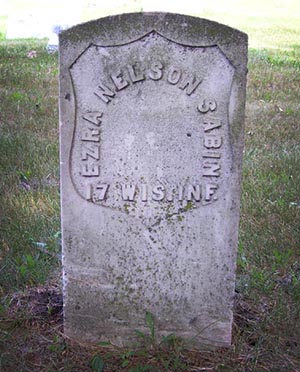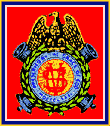Ezra Nelson Sabin
 Private Ezra Nelson Sabin was a 16-year-old replacement soldier who was captured in 1865 along with about 1,000 other Union men in North Carolina.
Private Ezra Nelson Sabin was a 16-year-old replacement soldier who was captured in 1865 along with about 1,000 other Union men in North Carolina.
Sabin served from Oct. 18, 1864, to July 14, 1865. He was born on April 27, 1848, and died at age 86 on Feb. 25, 1935. He was from Durand and is buried there.
In the Wisconsin roster, he is listed as Nelson Sabine and as being in the 17th Wisconsin Infantry Regiment, but he was one of more than 150 men in the 17th who are listed as unassigned. They have this asterisk in the unit roster:
"The names thus designated were assigned to the 17th Wis. Vet. Vol. Inf., but never joined the regiment; they were temporarily attached to the Dept. of the Cumberland, and at the battle of Kingston, N.C., Mar. 10, 1865, they, under the command of Col. C.J. Upham, 15th Conn. Vol. Inf., were mostly killed, captured or wounded; nothing further is known respecting them."
That is described as being "from remarks on (muster-out) roll of detachment, dated July 14, '65."
Those 150 men cover three pages of the Wisconsin roster (pages 80 to 82 of the second volume). A few actually are listed as killed at Kingston, dying of wounds there or being captured there. Nothing like that is given for Sabin, but his local newspaper obituary said: "He was taken prisoner by the Confederate forces and taken to Libby prison (in Richmond, Va.) until he was paroled …."
The battle site actually is spelled as Kinston. It is in eastern North Carolina.
The fight there is known as the Battle of Wyse Fork or the Battle of Wilcox's Bridge, among other things. It was fought March 7-10, 1865, and had 12,000 Union troops battling 8,500 Confederates, with casualties of 1,257 Union and 1,500 Confederate.
A North Carolina Civil War Trails historical marker at Wyse Fork includes:
"On the morning of March 8, (Confederate Gen. Robert) Hoke assaulted the Union left flank, and later in the day Gen. D. H. Hill attacked the Federal right in support. Hoke's attack fell on Col. Charles L. Upham's brigade, which included the 15th Connecticut and 27th Massachusetts Infantry Regiments, and most of the brigade was killed, wounded, or captured. Between them, Hoke and Hill seized about a thousand prisoners, the last large capture of Union troops in the war."
The overall 17th Wisconsin was not at Kinston. It was between fighting at Columbia Feb. 16-17 and the Battle of Bentonville, N.C., March 19-21. It then was at Bennett's House and the surrender, and marched in the Grand Review in Washington, D.C., on May 24. It mustered out at Louisville, Ky., on July 14, the same day that Sabin departed the Army.
The 15th Connecticut was at Kinston, according to Civil War Archive. The 27th Massachusetts was in "movements on Kinston March 4-12, Southwest Creek March 7 *and) Wise's Forks March 8-10."
By the time Sabin had enlisted, the 17th already had fought for more than two years, at places such as Corinth and Vicksburg, Miss., and at several sites in the Atlanta Campaign. Perhaps the new group that included Sabin was not assigned in the veteran 17th because in general, battle-hardened soldiers did not trust large groups of new people, including those made up mostly of draftees like the 17th's new group was. That fact often is mentioned in many Civil War books about many units. The new group is given to someone else for a period to get accustomed, or is put on rudimentary duty.
After the war Sabin returned to Pepin County, took up farming in Lima Township, and married Martha Hardy. The couple had one child, who died in infancy. In 1883 they moved to Durand, where Sabin built the house in which he lived for the rest of his life, and engaged in a variety of businesses with siblings and other partners. One such business owned a gasoline-powered launch and a barge, used to float logs down the Chippewa River.
Sabin was active in political affairs, and held several municipal offices. He served for a period of time in the office of the county sheriff and was chief of the Durand Volunteer Fire Department for at least 15 years. He was a charter member of the Charles Coleman Post #82 of the Grand Army of the Republic in Durand, and served as its first quartermaster sergeant. He was an avid outdoorsman, and shot his last deer at the age of 83; his first deer was when he was 10.
Although the Coleman Post disbanded in 1924 due to declining membership, Sabin was accorded the honor of burial with the ritual of the GAR. John W. Pepper of the Eagle Post #52 of the GAR in Eau Claire served as presiding officer. Commander Ben Haag of the Michael Griffin Camp of the Sons of Union Veterans in Eau Claire was chaplain. Further honors were rendered by the Durand Post #181 of the American Legion.
Information Sources:
Civil War Archive: 17th Wisconsin Infantry
Roster of Wisconsin volunteers, War of the Rebellion, 1861-1865: Volume 2, Page 82. Roster of Recruits not on Company Rolls or Improperly Assigned
Virginia Tech Essential Civil War Curriculum: Army of the Cumberland
Wyse Fork historical marker
Wikipedia: Battle of Wyse Fork
Wikipedia: Wyse Fork Union Order of Battle
Wikipedia: Carolinas Campaign Union Order of Battle
Civil War Archive: 15th Connecticut Infantry
Wikipedia: Kinston, North Carolina
Find-a-Grave
Compiled by Tom Mueller, PCC and Department GRO; and John R. Decker, PDC
Sons of Union Veterans of the Civil War
Department of Wisconsin

Comments to
Last Updated: 29 Dec 2022